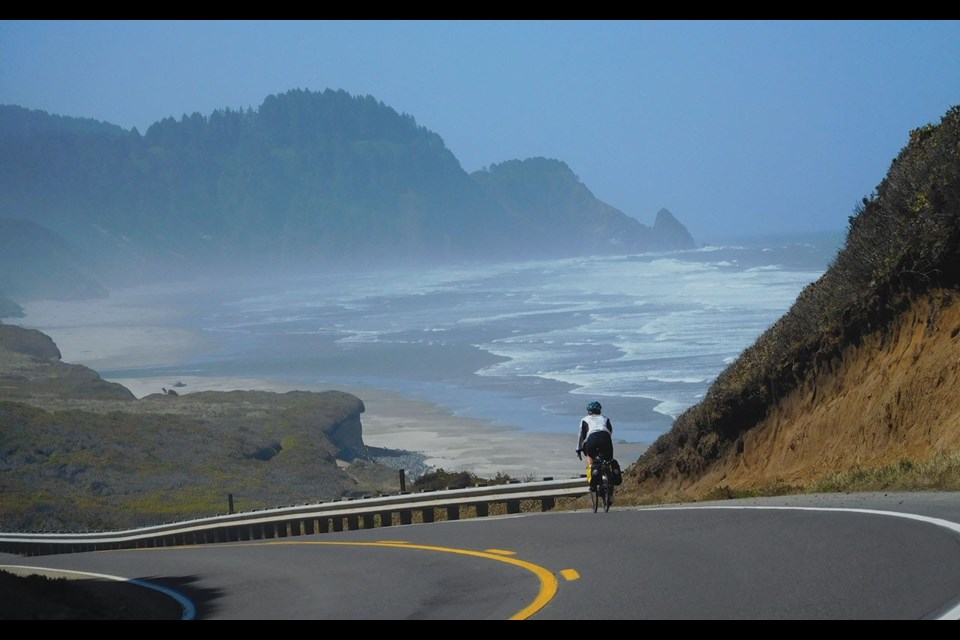Some Pique readers may recollect the many stories I have written about cycling trips including Hawaii (April 9, 2015), Jamaica (March 17, 2017) and France (Sept. 27, 2015).
This time, our bike tour was in another American state with spectacular Pacific coastlines: Oregon, which is accessible by bicycle-friendly Amtrak Cascades rail service from Vancouver. Having already done the wonderful Willamette Valley and much of the Columbia River Valley, it was finally the time to do my favourite state's world-famous coastline.
Its popularity as a bike route, however, had long made me wary. Like most trendy bike routes, e.g. our own Highway 99, I feared it would bear motor traffic in volumes far beyond my international standard. I don't like to be overtaken by more than three motor vehicles per minute.
Indeed, Oregon's coastal Highway 101 was too busy, overpopulated in particular by RVs pulling SUVs! Such forms of travel have boomed in North America in this era of cheap fuel. Maybe the retirees who favour this carbon-intense mode of transport reckon they won't be around to witness the worst consequences of global warming.
Narrow shoulders on some stretches rendered these behemoths even more intimidating. But the annoyance was mitigated by a consistently strong tailwind. The faster you pedal, the less often you are overtaken by motorhomes!
Dumb luck? Not really. After all, Northwest is the prevailing winds direction here. Yet we saw many silly cyclists riding the wrong way... not only fighting the wind but also with two to four lanes of asphalt and traffic separating them from their view of the sea.
As anticipated, the riding was consistently better after we left the coast behind to enjoy the quiet roads of the state's interior.
How quiet? Well, on one stretch, Highway 1 from Canyonville to Prospect, through Umpqua National Forest, I believe we averaged three overtakes per... hour!
Not only was there no traffic, but there were also no services of any kind for 96 kilometres, a fact recognized by kind locals who passed us cool water bottles out their car windows. We felt like we were in the Tour de France!
Crater Lake National Park is another of Oregon's famous attractions, so understandably motor traffic picked up again there, but its surrealistic beauty and its old-growth forest were definitely worth the aggravation, and also worth the big climb.
We were now 2,350 metres above the Pacific Ocean. Photo ops abounded but so did mosquitoes, so we limited our stops. My partner Hisano Motohashi, being a Tokyo girl, has a particularly low tolerance for biting insects. On the other hand, I'm much more appreciative of their existence. Not only do they make good bird food but also I grew up in a swampy forest in Ontario where I learned at a tender age that cycling was one outdoor activity that conferred immunity to their assault, as long as one kept pedalling.
I haven't stopped since.
On this journey I wasn't only gathering new lines for my garage wall route map collection, but I was also bagging several more charming historic covered bridges, rare elsewhere in western North America.
Concentrated in the eastern half of our continent, as well as in Western Europe and eastern China, only 2,000 authentic structures remain standing, worldwide (no, Whistler's doesn't count!). I not only value them for their individual charm (no two are alike) but I consider their presence a reliable indicator of ideal bike tour "habitat."
They are almost invariably found in the kind of bucolic landscape that every bike traveller dreams about and they are often associated with other historic structures. Maybe best of all, you cannot drive a truck, bus or RV through them!
I've pedalled through 250 of them, adding six more on this trip.
Neglecting all non-vital functions over the course of the journey, we'd devoted ourselves to a routine of bike-eat-sleep-repeat, wasting as little time as possible indoors during the abundant daylight hours of last June. So on the long train ride back to B.C. from Eugene, I caught up on correspondence, while Hisano caught up on... sleep.
Some readers may recall that in my Hawaii cycling travel column I made some tongue-in-cheek comments about Hisano — which she took a little exception to as she felt they made her sound slow on the bike.
Let me say that the principle content of my 31 postcards on the train ride raved about Hisano's performance. She'd always been a good sleeper, but now she had also become a formidable cyclist.
Averaging more than 1,600 vertical metres of climbing daily (Whistler mountain's vertical), we had just covered 1,500 km in 8.5 days. We did seven consecutive "centuries" — American bike lingo for a minimum of 100 miles (161 kms) in a day. Kind of like doing a Whistler GranFondo every day, but with loaded panniers.
Evidently that Hawaii Pique article had created a monster. It's amazing what Hisano can do when she doesn't waste time relaxing on a beach.




